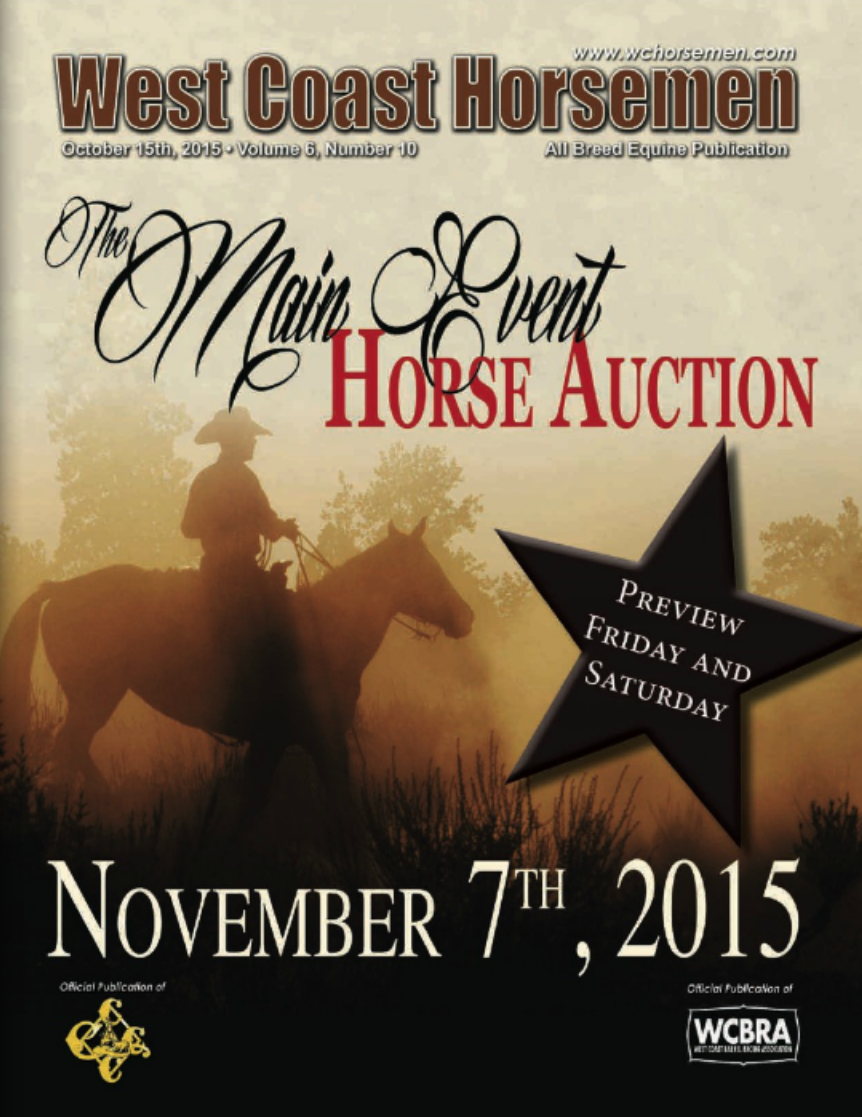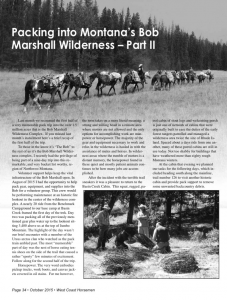 As published in the West Coast Horsemen Magazine, Oct. 2015 Issue
As published in the West Coast Horsemen Magazine, Oct. 2015 Issue
Last month we recounted the first half of a very memorable pack trip into the over 1.5 million acres that is the Bob Marshall Wilderness Complex. If you missed last month’s installment here’s a brief recap of the first half of the trip.
To those in the know it’s “The Bob” to the rest of us it’s the Bob Marshall Wilderness complex. I recently had the privilege of being part of a nine-day trip into this remarkable, and very bucket list worthy, region of Northwest Montana.
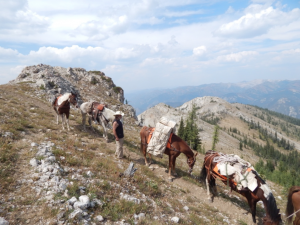 Volunteer support helps keep the vital infrastructure of the Bob Marshall open. In August of 2015 I had the opportunity to help pack gear, equipment, and supplies into the Bob for a volunteer group. This crew would be performing maintenance at an historic fire lookout in the center of the wilderness complex. A nearly 20 ride from the Benchmark Campground to our base camp at Basin Creek framed the first day of the trek. Day two was packing all of the previously mentioned gear plus water up to the lookout sitting 3,400 above us at the top of Jumbo Mountain. The highlight of the day wasn’t our brief encounter with a member of the Ursus arctos clan who watched as the pack train ambled past. The most “memorable” part of day was the nest of horse eating tennis shoes on the side of the trail that caused a rather “sporty” few minutes of excitement. Follow along for the second half of the trip.
Volunteer support helps keep the vital infrastructure of the Bob Marshall open. In August of 2015 I had the opportunity to help pack gear, equipment, and supplies into the Bob for a volunteer group. This crew would be performing maintenance at an historic fire lookout in the center of the wilderness complex. A nearly 20 ride from the Benchmark Campground to our base camp at Basin Creek framed the first day of the trek. Day two was packing all of the previously mentioned gear plus water up to the lookout sitting 3,400 above us at the top of Jumbo Mountain. The highlight of the day wasn’t our brief encounter with a member of the Ursus arctos clan who watched as the pack train ambled past. The most “memorable” part of day was the nest of horse eating tennis shoes on the side of the trail that caused a rather “sporty” few minutes of excitement. Follow along for the second half of the trip.
Horsepower. The very word embodies pickup trucks, work boots, and canvas jackets covered in oil stains. For me however, the term takes on a more literal meaning; a strong and willing beast in a remote area where motors are not allowed and the only options for accomplishing work are manpower or horsepower. The majority of the gear and equipment necessary to work and relax in the wilderness is hauled in with the assistance of mules and horses. In wilderness areas where the rumble of motors is a distant memory, the horsepower found in these quiet and mostly patient animals continues to be how many jobs are accomplished.
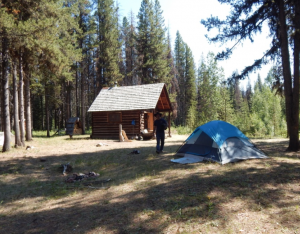 After the incident with the terrible trail sneakers it was a pleasure to return to the Basin Creek Cabin. This squat, rugged, patrol cabin of stout logs and welcoming porch is just one of network of cabins that were originally built to ease the duties of the early forest rangers patrolled and managed a wilderness area twice the size of Rhode Island. Spaced about a days ride from one another, many of these patrol cabins are still in use today. Not too shabby for buildings that have weathered more than eighty rough Montana winters.
After the incident with the terrible trail sneakers it was a pleasure to return to the Basin Creek Cabin. This squat, rugged, patrol cabin of stout logs and welcoming porch is just one of network of cabins that were originally built to ease the duties of the early forest rangers patrolled and managed a wilderness area twice the size of Rhode Island. Spaced about a days ride from one another, many of these patrol cabins are still in use today. Not too shabby for buildings that have weathered more than eighty rough Montana winters.
At the cabin that evening we planned our tasks for the following days, which included heading south along the mainline, trail number 126 to visit another historic cabin and provide pack support to remove some unwanted backcountry debris.
Our destination point, the Danaher Cabin, sits on the edge of the appropriately named Danaher Meadow and not only functions as another patrol cabin, it is also a vestige of one of the area’s original homesteads from the 1800’s. Thomas Danaher homesteaded 160 acres in this remote meadow in 1898 through the early 1900’s. Sharp eyes can still catch glimpses of rusting farm equipment scattered here and there in the meadows. Our task at Danaher was to load and pack out rolls of old barbed wire that is out of place in this pristine environment. But before we could pack the wire out we had to make our way south to the meadow and that would prove to be more than a simple trail ride.
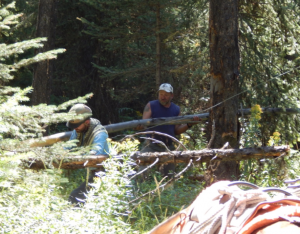 Trail 126 is a well-traveled thoroughfare that runs north and south from Big Prairie to the Flathead Divide. At the southern end of that stretch is Danaher Cabin. From Basin Creek the trail is wide and flat as it follows along Danaher Creek. After the first few miles the terrain changes and soon the creek was hundreds of feet below a now very narrow trail. Once we made our way carefully past the few sporty sections of trail tread we dropped back to the creek’s edge and encountered the first of the many obstacles that had to be cleared before we could venture on. A brief storm the previous evening had brought down more than few trees that were blocking the trail. Riding at the front of the pack train, with only a single pack animal in tow, I had the unenviable job of dismounting at each fallen log, clearing the trail, then climbing back on and riding down the trail another few minutes and repeating the operation.
Trail 126 is a well-traveled thoroughfare that runs north and south from Big Prairie to the Flathead Divide. At the southern end of that stretch is Danaher Cabin. From Basin Creek the trail is wide and flat as it follows along Danaher Creek. After the first few miles the terrain changes and soon the creek was hundreds of feet below a now very narrow trail. Once we made our way carefully past the few sporty sections of trail tread we dropped back to the creek’s edge and encountered the first of the many obstacles that had to be cleared before we could venture on. A brief storm the previous evening had brought down more than few trees that were blocking the trail. Riding at the front of the pack train, with only a single pack animal in tow, I had the unenviable job of dismounting at each fallen log, clearing the trail, then climbing back on and riding down the trail another few minutes and repeating the operation.
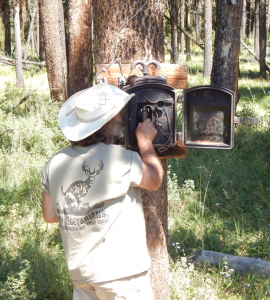 In addition to the company of fallen trees a phone line accompanied us on our route. Yes, a phone line, in the middle of a vast wilderness, stretched into the distance in front of us. Although phone and electrical wires are common sights closer to civilization, this was the last thing that I expected to see deep inside the Bob.
In addition to the company of fallen trees a phone line accompanied us on our route. Yes, a phone line, in the middle of a vast wilderness, stretched into the distance in front of us. Although phone and electrical wires are common sights closer to civilization, this was the last thing that I expected to see deep inside the Bob.
The backstory of the phone line is fascinating. After the massive 1910 fire that burned over 3 million acres of Washington, Idaho and Montana the Forest Service built a vast phone system connecting backcountry administrative sites. Before you start dreaming of ordering pizza while in the backcountry, only 39 miles of this network still survive and run from Black Bear Cabin to Danaher Cabin: connecting a total of five patrol cabins with a thin strand of #9 galvanized wire winding through the forest.
The thin wire led the way and after a few more miles and a few more logs to clear we found ourselves at one of the prettiest meadows that I’ve ever seen. Lush green grass, wildflowers, a weathered cabin, log corral, and even a quaint outhouse tucked to the side. It’s a pretty place where you can imagine life a century ago. And then there was the pile of rusty barbwire. Out of place and unwanted. We were there to haul it away. Five people and seven pack animals; we were up to the job.
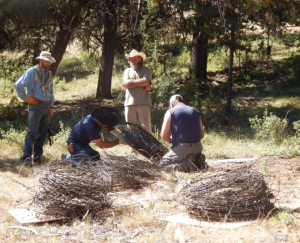 Barbwire is wily, like a skittish calf, and corralling it into trail stable bundles required some veteran packer knowhow as well as a fair bit of improvising. Wire ties compressed the unruly rolls into slightly less unruly rolls that were then sandwiched between two stout sheets of plywood. Each package was then secured with manti ropes and finally loaded onto the pack animals.
Barbwire is wily, like a skittish calf, and corralling it into trail stable bundles required some veteran packer knowhow as well as a fair bit of improvising. Wire ties compressed the unruly rolls into slightly less unruly rolls that were then sandwiched between two stout sheets of plywood. Each package was then secured with manti ropes and finally loaded onto the pack animals.
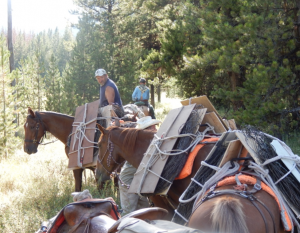 It was late afternoon before the train was ready to begin our return trip laden with squeaky loads that complained and threatened to burst in a whirling tangle with each step. Slowly we retraced our earlier route, following the phone line like a backcountry handrail through vast meadows, under imposing mountains, and over narrow trails. Three hours later in the final dying rays of sunlight we were back at the welcoming porch of our wilderness home where we could unload the animal’s burdens.
It was late afternoon before the train was ready to begin our return trip laden with squeaky loads that complained and threatened to burst in a whirling tangle with each step. Slowly we retraced our earlier route, following the phone line like a backcountry handrail through vast meadows, under imposing mountains, and over narrow trails. Three hours later in the final dying rays of sunlight we were back at the welcoming porch of our wilderness home where we could unload the animal’s burdens.
A few days later we would load the noisy wire cargo one last time, along with the rest of our camp and gear and make our way slowly out of the wilderness. Along with removing over 500 pounds of trash we were also taking a lifetime of memories with us.
As always for the latest and best in information on this and other trailhead and horse camping locations visit www.trailmeister.com, your horse trail and camping guide.


